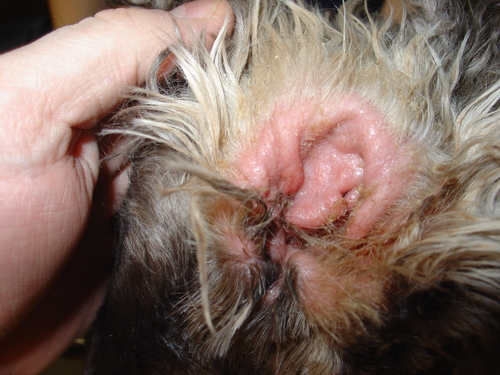Probably one of the most common reasons people bring their dogs and cats into our clinic is for ear infections. Owners will commonly see their pet scratching their ears, shaking or rubbing their heads on the floor, or maybe notice an odd discharge or smell coming form the ear canal. Many of you have probably seen this issue with your pet before, but what triggers an animal to get an ear infection? There are surprisingly many factors that can contribute to the development of an ear infection. Let’s start by breaking them down and giving you some wisdom on how to reduce the recurrence of ear infections in your pet.
One of the common contributors to ear infection in young puppies and kittens are ear mites (also known as Otodectes cynotis). Ear mites are a type of parasites barely visible to the naked eye and are highly contagious in multi-pet households. Treatment for these little bugs is easy and requires either topical or systemic anti-parasitic medications. In older dogs and cats, certain factors like excessive moisture, excessive ear hair in the ear canal, narrow ear canals, polyps, and sometimes certain cancers can predispose an animal to develop an ear infection. Certain auto-immune disorders, endocrine diseases (e.g. Cushing’s, hypothyroidism), and chronic allergies can all play a role in an animal developing recurring ear infections throughout their lifetime.
As you can see, there are many things that can contribute to an animal developing an ear infection. This is why it is important for us to identify an underlying cause and treat the problem to help prevent relapsing ear infections in the future.

Now what exactly do we see festering in an ear infection once it sets up shop in your pets ear? The two most common organisms are yeast and bacteria. It’s important during an office visit for us to examine the ear canal with a scope and swab the pets ear to see what is causing the infection and dispense the appropriate medications for that specific condition, Unfortunately, every now and then you can get resistance bacteria in the ear that will require culture and sensitivity testing to identify the appropriate antibiotic the bacteria is susceptible to. Once the ear infection has resolved, there are some things you as an owner can do to reduce the chances of another ear infection from developing.
The first thing is to use a good ear cleaner on your animal routinely. Cleaning the ears out once a week will help reduce moisture and ear wax build up in the animal. Secondly, giving your animal the appropriate medications if the ear infections are triggered by underlying disease processes mentioned earlier like allergies or endocrine disorders. Lastly, removing ear hair. This might be difficult for yourself at home, but asking your groomer or your veterinarian to remove the hair will help keep your pets ear canal well ventilated. Doing these few things will help keep your furry friend happy, healthy, and less miserable when their ears aren’t full of nasty bacteria and/or yeast.

Recent Comments